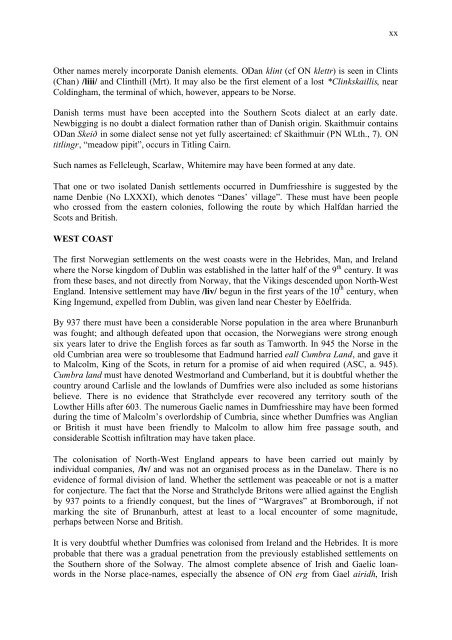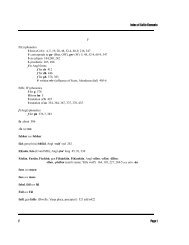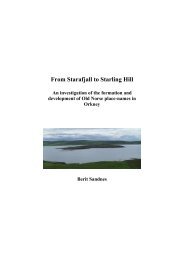May Williamson: The Non-Celtic Place-Names of the Scottish Border ...
May Williamson: The Non-Celtic Place-Names of the Scottish Border ...
May Williamson: The Non-Celtic Place-Names of the Scottish Border ...
Create successful ePaper yourself
Turn your PDF publications into a flip-book with our unique Google optimized e-Paper software.
xx<br />
O<strong>the</strong>r names merely incorporate Danish elements. ODan klint (cf ON klettr) is seen in Clints<br />
(Chan) /liii/ and Clinthill (Mrt). It may also be <strong>the</strong> first element <strong>of</strong> a lost *Clinkskaillis, near<br />
Coldingham, <strong>the</strong> terminal <strong>of</strong> which, however, appears to be Norse.<br />
Danish terms must have been accepted into <strong>the</strong> Sou<strong>the</strong>rn Scots dialect at an early date.<br />
Newbigging is no doubt a dialect formation ra<strong>the</strong>r than <strong>of</strong> Danish origin. Skaithmuir contains<br />
ODan Skeið in some dialect sense not yet fully ascertained: cf Skaithmuir (PN WLth., 7). ON<br />
titlingr, “meadow pipit”, occurs in Titling Cairn.<br />
Such names as Fellcleugh, Scarlaw, Whitemire may have been formed at any date.<br />
That one or two isolated Danish settlements occurred in Dumfriesshire is suggested by <strong>the</strong><br />
name Denbie (No LXXXI), which denotes “Danes’ village”. <strong>The</strong>se must have been people<br />
who crossed from <strong>the</strong> eastern colonies, following <strong>the</strong> route by which Halfdan harried <strong>the</strong><br />
Scots and British.<br />
WEST COAST<br />
<strong>The</strong> first Norwegian settlements on <strong>the</strong> west coasts were in <strong>the</strong> Hebrides, Man, and Ireland<br />
where <strong>the</strong> Norse kingdom <strong>of</strong> Dublin was established in <strong>the</strong> latter half <strong>of</strong> <strong>the</strong> 9 th century. It was<br />
from <strong>the</strong>se bases, and not directly from Norway, that <strong>the</strong> Vikings descended upon North-West<br />
England. Intensive settlement may have /liv/ begun in <strong>the</strong> first years <strong>of</strong> <strong>the</strong> 10 th century, when<br />
King Ingemund, expelled from Dublin, was given land near Chester by Eðelfrida.<br />
By 937 <strong>the</strong>re must have been a considerable Norse population in <strong>the</strong> area where Brunanburh<br />
was fought; and although defeated upon that occasion, <strong>the</strong> Norwegians were strong enough<br />
six years later to drive <strong>the</strong> English forces as far south as Tamworth. In 945 <strong>the</strong> Norse in <strong>the</strong><br />
old Cumbrian area were so troublesome that Eadmund harried eall Cumbra Land, and gave it<br />
to Malcolm, King <strong>of</strong> <strong>the</strong> Scots, in return for a promise <strong>of</strong> aid when required (ASC, a. 945).<br />
Cumbra land must have denoted Westmorland and Cumberland, but it is doubtful whe<strong>the</strong>r <strong>the</strong><br />
country around Carlisle and <strong>the</strong> lowlands <strong>of</strong> Dumfries were also included as some historians<br />
believe. <strong>The</strong>re is no evidence that Strathclyde ever recovered any territory south <strong>of</strong> <strong>the</strong><br />
Low<strong>the</strong>r Hills after 603. <strong>The</strong> numerous Gaelic names in Dumfriesshire may have been formed<br />
during <strong>the</strong> time <strong>of</strong> Malcolm’s overlordship <strong>of</strong> Cumbria, since whe<strong>the</strong>r Dumfries was Anglian<br />
or British it must have been friendly to Malcolm to allow him free passage south, and<br />
considerable <strong>Scottish</strong> infiltration may have taken place.<br />
<strong>The</strong> colonisation <strong>of</strong> North-West England appears to have been carried out mainly by<br />
individual companies, /lv/ and was not an organised process as in <strong>the</strong> Danelaw. <strong>The</strong>re is no<br />
evidence <strong>of</strong> formal division <strong>of</strong> land. Whe<strong>the</strong>r <strong>the</strong> settlement was peaceable or not is a matter<br />
for conjecture. <strong>The</strong> fact that <strong>the</strong> Norse and Strathclyde Britons were allied against <strong>the</strong> English<br />
by 937 points to a friendly conquest, but <strong>the</strong> lines <strong>of</strong> “Wargraves” at Bromborough, if not<br />
marking <strong>the</strong> site <strong>of</strong> Brunanburh, attest at least to a local encounter <strong>of</strong> some magnitude,<br />
perhaps between Norse and British.<br />
It is very doubtful whe<strong>the</strong>r Dumfries was colonised from Ireland and <strong>the</strong> Hebrides. It is more<br />
probable that <strong>the</strong>re was a gradual penetration from <strong>the</strong> previously established settlements on<br />
<strong>the</strong> Sou<strong>the</strong>rn shore <strong>of</strong> <strong>the</strong> Solway. <strong>The</strong> almost complete absence <strong>of</strong> Irish and Gaelic loanwords<br />
in <strong>the</strong> Norse place-names, especially <strong>the</strong> absence <strong>of</strong> ON erg from Gael airidh, Irish




